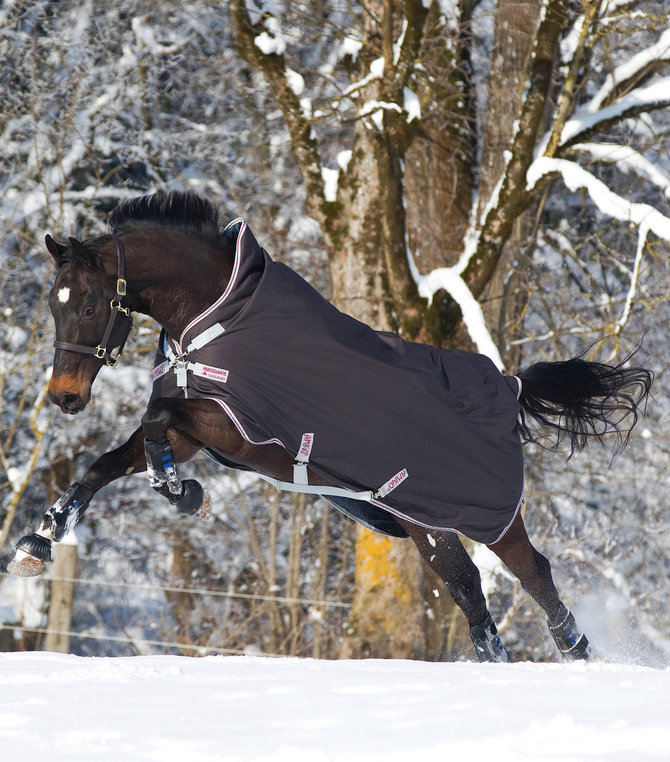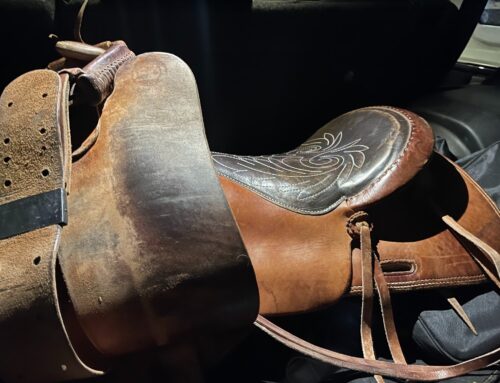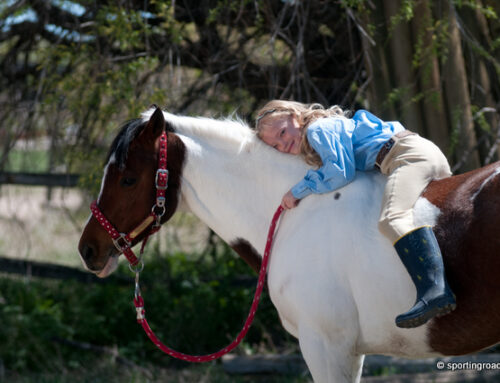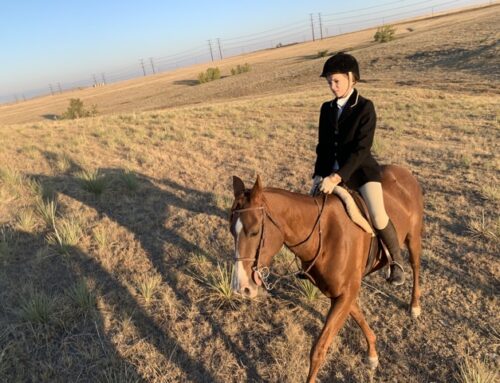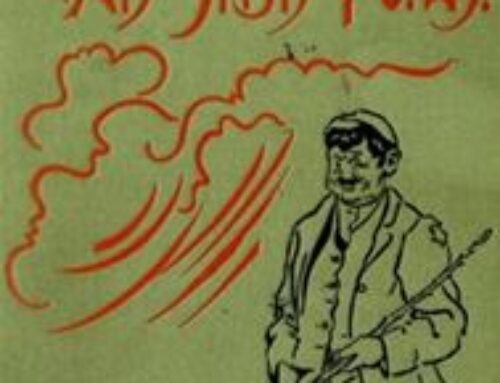Blanket Size Examples
Snickers 13.2 hands = 63″ blanket
Debon 15.3h = 74″ blanket
Dash, Rosa 76
Yukon 78
Reilly/River 16.3h = 82″ blanket
Blanketing 101 – Adapted to Colorado’s Requirements, Mostly Taken From a Dover’s Newsletter
Here, in Colorado are the answers to these most commonly asked questions to help you make your horse comfortable this season. For blanket repairs and cleaning, we think that Kerry Martin, KLM Blanket Cleaning and Repair is the best that we have ever found and reasonably priced at (720) 341-4955.
1. Why so many blanket weights?
Horse clothing manufacturers offer a range of weights in their blanket collections to allow the perfect choice for every horse based on its personal needs and its environmental conditions. The weight of a blanket refers to grams of poly fill between the inner and outer layers. The fill insulates a horse from the cold by trapping its body heat; the higher the number of grams of fill, the warmer and heavier the blanket will be.
Lightweight turnout blankets from some manufacturers have 100 grams of fill in the center. Other manufacturers refer to their turnout sheets as lightweights, so be sure to take note of fill when shopping for a light blanket. Mid-weight or medium weight turnouts have 180 to 200 grams of fill. Heavyweight turnouts typically have 300 to 440 grams of fill.
For Colorado, we recommend that you get a turnout sheet and a heavy weight waterproof turnout blanket. You can double layer them when it is really cold.
If you don’t have a groom that lives on site, the Horseware® HorsePal Monitor and App, exclusively FREE with a Rambo blanket purchase, can help you understand and predict your horse’s blanketing needs accurately. Using actual data, HorsePal eliminates guesswork in choosing your horse’s coverage on any given day. A small monitor inside the blanket senses and records the inner temperature and humidity. That temperature, plus local weather information, is stored in the Cloud for retrieval by the App on your smartphone. You can check on your horse’s current conditions, and get blanketing recommendations based on the data and the forecast for the next three days.

2. How do I know what weight blanket to put on my horse?
Multiple factors influence the right weight blanket for any horse on any given day. All horses’ needs are different. Consider whether your horse:
- has a thick or thin hair coat.
- is unclipped, partially or fully clipped.
- runs warm or is chilled and shivers easily.
- lives inside, outside or is turned out without shelter.
- is an easy keeper or a hard keeper, or compromised by health issues.
- recently transplanted from a warm geographic area to a cooler one or vice versa.
To these considerations, factor in weather conditions and temperatures for the day. Always err on the side of a lower weight blanket rather than a heavier weight. If your horse becomes overheated, he can perspire inside the blanket. The moisture can then cause chills as he cools.
A lightweight turnout blanket with 100 grams of fill might be perfect for mild winter days or when temperatures are just starting to cool in fall or warm up in spring. Many horses do well with a medium weight blanket during most of their winter seasons. Heavyweight blankets, with neck covers, may be critical for use on a fully clipped horse and for extreme cold weather conditions. However, the warmth they provide may be too much for some horses in some conditions.
For extra help, try our new Dover Blanket Wizard to find out what blanket to put on your horse each day.
3. How do I know what size to get for my horse?
A good fit in a blanket is essential for comfort and security. This photograph helps you see how a horse clothing manufacturer’s sizing is determined. The blanket is placed flat and smooth with fastenings undone. Any gussets or darts would be spread flat, too. A soft fabric tape measure with inch measurements runs from front binding to back binding, and sits just at base of the neck opening.

To determine the size blanket your horse needs, stand him squarely on level ground. Use a soft fabric tape meaure running from the center of your horse’s chest (where the base of the neck meets the chest) over the point of his shoulder, to the point at which you want the blanket to end. The inch measurement you obtain translates to the blanket size you should try.
4. How do I know if the blanket fits my horse right?
Take these easy steps to be sure your horse’s blanket fits correctly.
Step 1. Place the blanket on your horse and fasten the chest closure. A perfect fit allows fabric at the chest to overlap, and the fastener to be adjusted near the middle. The tail seam should now sit at the point where you want the coverage to end.
Step 2. Check your ability to slide your hand under the blanket all around the neck and over the withers with your horse’s head in a grazing position and when raised. If the opening is too small, the blanket will pull or rub the withers, mane or points of the shoulders or tug at the base of the neck.If the opening is too large, your horse could get a foot caught, and it may rub your horse’s shoulders.
Step 3. Adjust belly closures, which may be two or three crossed or straight surcingles or a belly band. No matter what type closures you have, these straps should be adjusted so that you can slide only one flat hand between the strap and your horse’s belly. Looser straps can allow a horse’s leg to get tangled while lying down or rolling; tight straps can make the blanket rub.
Step 4. If the blanket has a tail strap, it should be adjusted so that you have about a hand’s width between the strap and your horse. If the blanket has leg straps, pass the left strap through your horse’s hind legs and clip it to the dee ring on the left side of the blanket. Cross right leg strap through the left leg strap and clip it to the dee ring on the right side. These straps should be adjusted so that you can fit only one hand’s width between the strap and the inside of your horse’s leg. If they are too long and hang down to your horse’s hocks, then a leg can become entangled. If the straps are too short, they may inhibit movement and chafe the tender insides of the gaskin or groin area.
Step 5. Stand back and look at the overall effect of the blanket on your horse. The shoulders of the blanket should not be stretched or tight over your horse’s shoulders, yet the blanket should not appear to sag or look too large either. The hem should not hang at or below your horse’s knees.

5. How do I stop my horses from ruining their blankets?
First, be sure you turn your horse out in a turnout blanket and not a stable blanket. Turnouts are waterproof and breathable, with outer tough outer shells made to stand up to the environment. Stable blankets are typically water-resistant only and feature softer fabric outer shells meant for inside use only.
Next, consider the denier of your turnout blanket. Denier refers to the thickness of the synthetic fabric used as the outer layer of the garment, and it provides an indication of how durable the garment will ultimately be. The higher the denier of the blanket, the heavier the fabric feels, and the stronger, more wind- and water-resistant the fabric is. A 1680 denier blanket is more durable than a 420 denier blanket. If your horse is turned out in rough terrain or enjoys rough play with pasture mates, then a higher weight denier is most appropriate.
Also consider some fabric terms you’ll encounter when looking for the toughest of turnout blankets: ripstop nylon and ballistic nylon. Ripstop nylon refers to a high denier fabric that is woven in a crosshatch pattern that, in the unlikely event a tear occurs, prevents the hole from spreading. Ballistic nylon refers to a thick and very tough synthetic fabric. It was originally designed for use in military jackets to protect the wearer from shell fragments and flying debris.
Lastly, be sure the leg straps or tail cord on the blanket is secured appropriately. These features are designed to help keep the blanket in place. If not secured properly, the blanket can shift and become entangled, trodden or torn.

